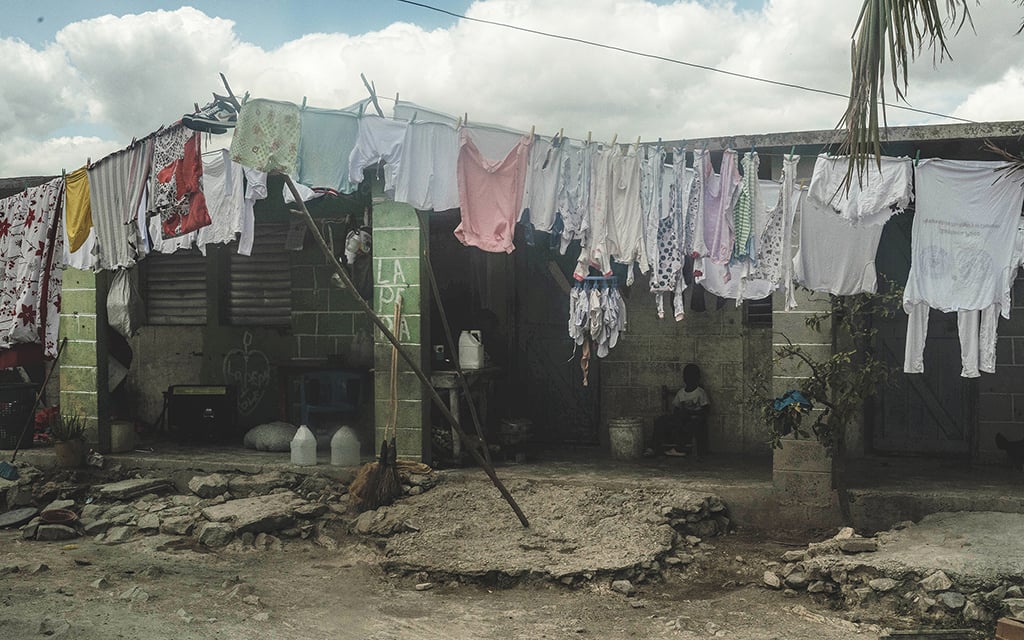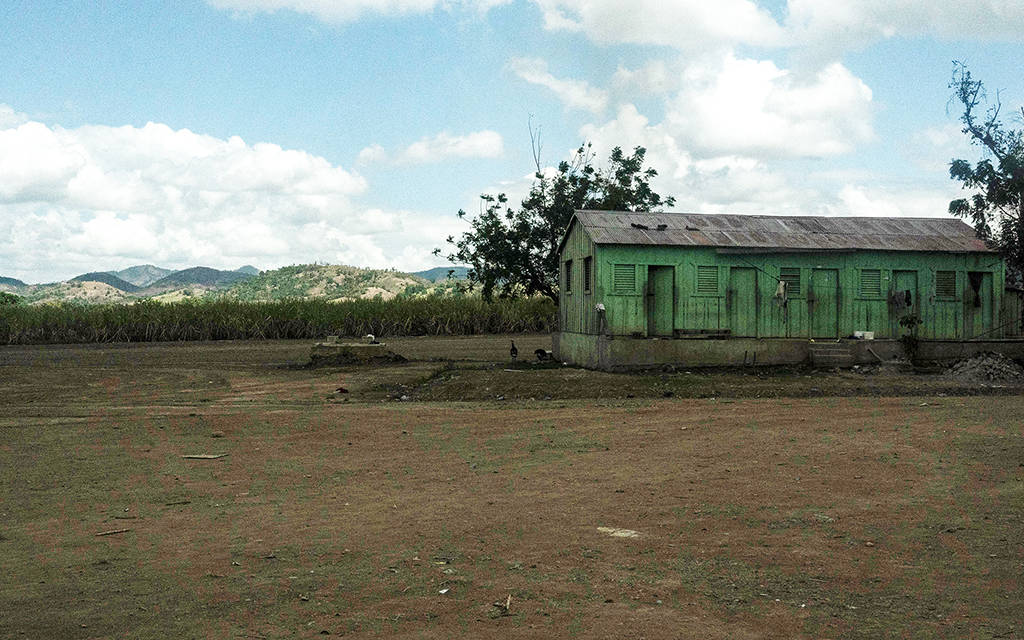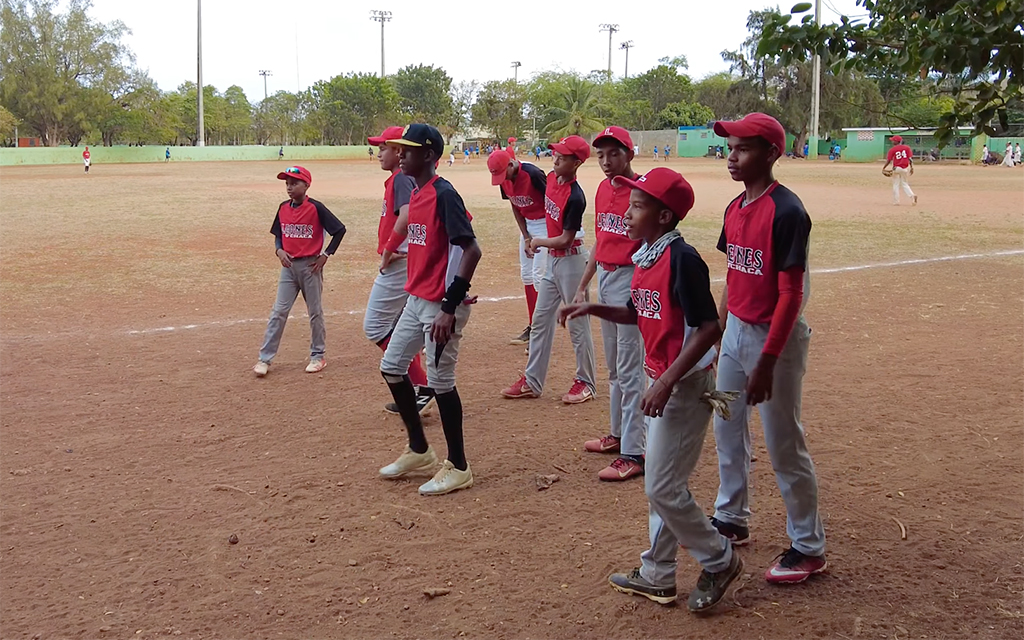
Laundry hangs in front of the “barracks,” a dwelling for families and single men in the Central Romana Batey. (Photo by John Leos/Cronkite Borderlands Project)
Multiple workers reported that agents of Central Romana warned residents in the bateyes against speaking to journalists under threat of forced eviction. For this reason, personal identifying information has been removed and names of workers have been changed for protection.
“They don’t want us to talk, but our life is not good.” – Central Romana employee
LA ROMANA, Dominican Republic – They call it a batey. The word itself is defined as a settlement around a sugar mill.
For workers who live in the bateyes of Central Romana, the largest sugar cane company in the Dominican Republic, it’s not just a settlement, it’s home, albeit in a company-owned shantytown that’s difficult to leave because for most of them, there’s nowhere to go.
Most workers in Dominican sugar cane fields are Haitian immigrants without documentation or people of Haitian descent whose Dominican citizenship was retroactively stripped by the Dominican government in 2013, making them vulnerable to deportation and dependent on private companies for places to live.
Many infants born in Dominican hospitals to Central Romana sugar cane workers, or cañeros, have no Dominican birth certificate or residency papers because their parents don’t have legal status in the country. They aren’t citizens of Haiti either, making them stateless. The lack of documentation makes it difficult for them to go to school or find work elsewhere — leaving generations of workers to toil in the fields and live in the bateyes.
Central Romana isn’t the only company whose workers live in bateyes. And some of the settlements remain even as the sugar mills they surrounded have wound down production. Estimates of the number of bateyes and people living in them vary widely. A 2015 United Nations Development Project report noted there were “approximately 425 bateyes in the national territory where approximately 200,000 people live.”
Central Romana, the largest exporter of Dominican sugar to the United States, has come under recent scrutiny because of its labor practices.
At the end of November, the U.S. Customs and Border Protection issued a withhold release order (WRO) on all sugar from Central Romana, stating that sugar imported from the company won’t be allowed into the U.S. The WRO was issued “based on information that reasonably indicates the use of forced labor in its operations.”
The CBP cited five indicators of forced labor in issuing the order: “abuse of vulnerability, isolation, withholding of wages, abusive working and living conditions and excessive overtime.”
The order continues to block U.S. imports of sugar from Central Romana.
“CBP will not modify or revoke a WRO until all the indicators of forced labor identified by the agency are sufficiently addressed and when it is satisfied that forced labor is no longer being used to produce the goods targeted by the order,” a Customs and Border Protection representative said.
In a press release, Central Romana said that the company has “great respect for every individual who works for our company, regardless of role, and in that regard, we have always provided appropriate wages, housing and other benefits.” The company did not respond to requests for further comment.
Workers living in the Central Romana bateyes told the Cronkite Borderlands Project of their struggles at work and in the bateyes.
Esther, a Haitian migrant who came to the Dominican Republic in 2005, said her husband works six days a week for 10 to 13 hours a day cutting sugar and he makes about 2,200 pesos, or about $40, every week — which isn’t enough to buy enough food for their five children.
If her husband stops working for the company, she said they will be evicted from the company-owned housing. Since she doesn’t have any legal documentation to stay in the country, her children lack documents, too. They are stuck at Central Romana.
“I have five kids, all of them born in the hospital. But when I asked for registration, they said ‘No you have to show me documents.’ As I don’t have documents, so I can’t have documents for my five kids,” Esther said.
Without documentation her children can’t attend public or private schools not owned by the company. Currently, her kids attend school that Central Romana provides in the bateyes, she said.

A Central Romana worker holds his grandchild in the batey. (Photo by John Leos/Cronkite Borderlands Project)
“Next year, we are going to be in trouble. Because my children cannot stay in this (Central Romana) school and have to go to another school far away from here, they will ask for documents. And that’s going to be a problem,” she said. “They are warning me that in seventh grade if you don’t have documents, you just stop there.”
Even if children do attend public schools, they cannot receive their diploma without documentation. The COVID pandemic further complicated things with online learning since many batey communities lacked access to electricity and internet, a report by the U.S. Department of Labor said.
Life in the bateyes
An electricity generator sits roaring in front of the two-room home where Roseline lives. The generator is a workaround to charge people’s phones since their batey has no electricity. Roseline was born in the Dominican Republic and so was her 2-month-old daughter, Lovelie. Lovelie lays swaddled in a blanket on the bed which takes up most of the space in the room. Because Roseline doesn’t have documentation, Lovelie doesn’t either.
Central Romana’s company website said that its bateyes are equipped with electricity, but no individual home we visited had electricity.
The workers said to keep their homes in the bateyes they must work in the fields or the mills. When workers get too old to work, they said, they are evicted.
James received a notice to pack up his things and leave his batey: he was being evicted. The reason? He had left his job at Central Romana and was working fixing homes in other bateyes with a coworker but he was still living in the company’s batey.
“They sent (the eviction) to me to make sure that I come back to that house and stay there,” James said.
He came back to Central Romana to work and he said the company left him alone and he was allowed to stay in his batey.
Becoming too old or too weak to work in the fields spells eviction. Esther said that she has seen many elderly workers evicted from their homes in the bateyes.

A batey in Central Romana next to the sugar cane fields where cañeros work. (Photo by John Leos/Cronkite Borderlands Project)
“There is a man who was my neighbor who lived in front of me. He’s not here anymore,” she said. “They put him out of his home because he’s weak now, he’s not strong enough to work in the sugar cane.”
Ricardo lives in a batey with his brother Stanley, who works at Central Romana cutting cane. Ricardo used to work for Central Romana but had to stop for health reasons as he has poor vision and type 1 diabetes. If his brother wasn’t working for the company, he couldn’t live in the batey.
“He’s living here because of us,” Stanley said.
Central Romana said on its website that it provides workers with health services. Ricardo gets his medication from a public hospital, he said.
Life in Central Romana is nothing new to Peterson.
“I was 10 years old when I started working in the sugar cane,” he said.
Peterson came to the Dominican Republic in 1961 and has been working for Central Romana ever since. He said he, his children and his grandchildren all received Dominican IDs. All of his three children work for Central Romana, either weighing sugar in the cane fields or as a waitress in Casa de Campo, a resort owned by the company with famed American visitors such as Beyoncé and former President Bill Clinton.
Unlike other workers interviewed, Peterson was lucky to receive his company pension of 10,000 pesos (or about $182.50) a month. Still, it wasn’t enough to support his family and so he continues working at Central Romana.
“I’m at an age to be retired. But if I don’t have anything to eat, I have to work and 10,000 (pesos) is not enough because food is expensive,” Peterson said. “10,000 isn’t even two weeks for us.”
Peterson works as an overnight security guard.
For many, working at Central Romana has become a generational commitment.

A woman stands in front of the window of her batey. (Photo by John Leos/Cronkite Borderlands Project)
Even though Peterson and his children have Dominican identification papers, it’s still dangerous to leave the batey. After the 2013 ruling, many documents previously issued to Haitian immigrants, or people of Haitian descent born in the Dominican Republic, are no longer considered valid by government officials.
“Yes we are afraid even though we have our ID in hand,” Peterson said.
Multiple workers interviewed mentioned immigration officials grabbing and deporting undocumented migrants, including targeting bateyes, which they said is a recent development.
Mario Jacobs, a Dominican lawyer who defends people who have been evicted from the bateyes, denied vacations or other issues – was himself born in the bateyes.
In 23 years, “I’ve probably represented about 3,000 workers,” Jacobs said. He said is currently working on 156 cases.
Most of the cases end favorably for the workers, he said.
“We’re working to make sure that workers get their labor benefits and then helping them obtain their pension (from the state),” Jacobs said.
The company has a labor union, Sindicato Unido de Trabajadores, that cañeros (sugar cane workers) pay dues to, but it doesn’t represent their interests, Jacobs said.
“It only covers a percentage of the workers and it doesn’t help them… It’s a union for workers in name, but only defends the company,” Jacobs said. “It doesn’t defend workers.”
Haitian hands, American stomachs
Although workers like Peterson are far from the continental United States, the sugar from their work has most likely been put into the hands of U.S. consumers.
About 28% of the sugar consumed in the United States is imported and America is the top buyer of the Dominican Republic’s sugar, with 100% of official exports from the country sent to the United States in Marketing Year 2020/21, according to statistics from the United States Department of Agriculture.
So far in production year 2022/2023, the United States is the world’s third-biggest sugar importer, sixth-highest producer and fourth-highest consumer, according to statistics from the USDA.

A cañero worker in Central Romana walks through the sugar cane field. (Photo by John Leos/Cronkite Borderlands Project)
For sugar imports, the United States has a tariff and quota system. Each country is given a quota, set by the United States Trade Representative, for how much sugar they can import before incurring prohibitively high tariffs. Despite not even being in the top 25 sugar producers in the world, the Dominican Republic has the highest quota allocation, 17% of the total, according to the USDA.
This means that the allocation that the Dominican Republic is given every year from the U.S. strongly influences how much sugar is produced.
Before the embargo, sugar export from the Dominican Republic was mainly from Central Romana, since it was the largest sugar producer.
“In this case, Central Romana has the highest volume because it’s the biggest producer,” said Ramón Darío Hidalgo, secretary of the Dominican Sugar Institute (INAZUCAR).
In fiscal 2022 Central Romana accounted for almost 63% of the Dominican Republic’s tariff and quota allocation, according to a report from the USDA.
The Dominican Republic has the capacity to increase sugar production, Isaac Terrero Sánchez, director of studies and sugar policies at INAZUCAR said, “but it depends largely on the allocation for the North American quota and the growth of the local market.”
“(The sugar industry is) extremely important. Last year, sugar exports with the U.S. had a value of (over) $130 million,” Sánchez said. “Those exports hold huge significance for the Dominican Republic’s trade balance.”
But the United States may have more influence in the sugar industry than just sugar exports – but in the actual business itself.
The Fanjul Corp., owned by Americans Alfonso Fanjul and J. Pepe Fanjul, acquired a large share of Central Romana in 1984 from American company Gulf + Western. Currently, Fanjul Corp. owns a 35% stake in Central Romana, according to court documents. The Fanjul family also owns Florida Crystals, which sells sugar under the brands Domino, C&H, Florida Crystals, Redpath and Tate & Lyle, and is the world’s largest producer of refined cane sugar.
In a lawsuit, Central Romana workers alleged that the company forcibly evicted them from their homes, “destroyed Plaintiffs’ homes and their personal property, and caused Plaintiffs to suffer physical and emotional injury,” according to court documents. The workers sued Fanjul Corp., alleging that the company was the “alter ego” of Central Romana. The case was dismissed in 2021, “finding Plaintiffs’ allegations that Fanjul owns 35% of Central Romana’s shares through a subsidiary and that Fanjul and Central Romana share four overlapping officers and directors were ‘insufficient to plead an alter ego theory’” the dismissal said.
The U.S. Department of Labor has issued periodic reports since 2013 about “egregious working conditions” in the Dominican Republic’s sugar industry. In its seventh periodic report, published in September 2022, it found that outreach and inspections have continued to fail workers and found several indicators of forced labor.
Nevertheless, workers like Peterson said he’ll remain at Central Romana and worries that his grandchildren will, too.
“I don’t have any hope for them because I don’t have anything,” he said.

